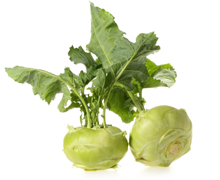
- Address : P.O. Box 11, Gannoruwa rd, Peradeniya, Sri Lanka
- E- Mail : director.hordi@doa.gov.lk
- Telephone :(+94) 081-2388011-12-13
- Fax :(+94) 081-2388234

Knol khol
Brassica oleraceae var. gongylodes
A vegetable belongs to cabbage family which is cultivated as an annual. Most cultivated as a mix crop with other vegetables
Released Varieties
Only recommended imported varieties are available
Climate requirements/ Areas suitable for cultivation
A day and night temperature difference is required for the development of knob (fleshy swollen stem). Knol-khol can be successfully grown in Nuwara Eliya and Badulla districts in wet and intermediate zones of up country. Cultivation in mid country and low country can be done during Maha season.
Soil
Well-drained, organic matter rich, pH around 5.5 soil is suitable for the cultivation.
Time of Cultivation
Most suitable season for cultivation is Maha. Start nurseries in mid-August and field establishment in September. Cultivation in October and later will affect negatively to develop the knob.
Seed requirement
Short duration varieties – 600 – 750 g/ha
Long duration varieties – 375 – 400 g/ha
Spacing
Between rows 30 cm and within rows 10 cm
Intercropping with cabbage – 50 x 50 cm
Intercropping with curry chili – 60 x 60 cm
Land preparation and Planting
Fine land should be prepared by ploughing and leveling without weeds. 3 -4 weeks old seedlings with 8 – 10 cm height ae suitable for planting in holes prepared according to the recommended spacing. 250 seedlings can be produced by 1 g of knol-khol seeds.
Nursery Management
Same as cabbage nurseries.
Fertilizer
Time of application | Urea (kg/ha) | Triple Supper Phosphate (kg/ha) | Muriate of Potash (kg/ha) |
Before planting | 85 | 110 | 65 |
2 weeks after transplanting | 85 | – | 65 |
Note: Better to apply Phosphorous and Potassium fertilizers to the soil after soil test
Water supply/ Irrigation
Maintenance of well moist soil is important. Knobs can be cracked if irrigate when soil is too dry.
Weed Control and earthing up
Hand weeding can be practiced at 2 – 3 weeks after transplant. Collect soils to the base of plant at 4-5 weeks.
Pest Management
Looper caterpillar, diamond black moth, black worm are common pests in cauliflower and management same as in cabbage
Disease Management
Club root and downy mildew are commonly can be seen at the field. Damping off at the nursery stage can be seen with poor drainage. Symptoms and disease management are similar to cabbage.
Causal Organism: plasmodiophora brassicae
Symptoms
- Swelling or malformation on the main lateral roots those are called club roots and those galls appear like clubs or spindles on the roots.
- The crop can be completely destroyed due to damage
Management
- Keeping the soil at a slightly basic pH of 7.1 – 7.2 by the addition of agricultural lime and apply 2-4 t/ha of lime to raise soil pH.
- Use of disease free planting materials
- As well as the integration of crop rotation
Causal Organism : Erysiphe cruciferarum
Symptoms
- Small white patched on upper and lower surface which may also show purple blotching , later powdery layer can be seen which coats the leaves
- leaves become chlorotic and drop from plant
Management
- Plant resistant varieties
- rotate crops
- Remove all crop debris after harvest
- Remove weeds
- Application of surface sprays, dusts or vapors
Causal Organism: Peranospora parasitica
Symptoms
- Infections of downy mildew begin as irregular yellow patches on leaves
- These chlorotic lesions later turn brown
- If conditions are favorable white fluffy growth of the fungus develops on the undersides of leaves
Management
- Covering the nursery to protect it from rain
- In the morning , remove the cover and allow get the sunlight
- Apply of a fungicide containing tebuconazole (5 ml for 10 liters of water) for once is recommended.
Harvesting
Harvest can be taken around 50 – 60 days after transplant. Quality of knobs affect when increasing fibrous nature with over maturity.
Yield
Intercropping with cabbage – 8000 kg/ ha
Intercropping with curry chili – 2200 kg / ha
